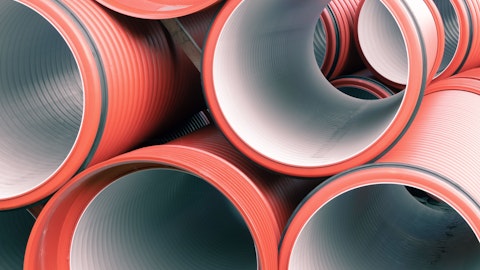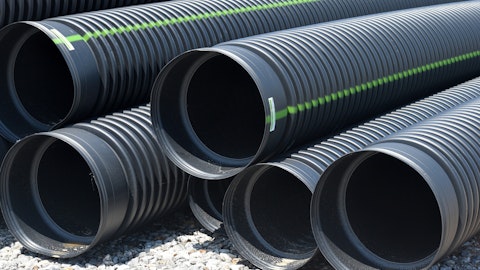We have a great foundation, a great baseline for margins. But is a room to run. Sure. But it’s going to come from other areas of that EBITDA bridge than what we’ve seen here over the last couple of years. And we know that, and we’re working hard on that. And the cash flow generation of ADS, you’ve seen it. We don’t take it for granted. We have a very disciplined approach, and we’re going to continue to put a lot of capital to work organically. We’re going to continue to stay open and look for great M&A opportunities. But right now, we’re going to spend a lot of money on efficiency, innovation, productivity in all of those areas I just covered. So again, a lot of runway in front of us as to the cadence of such. Stay tuned. We’ll talk more about that in May.
Matthew Bouley: Great. Well, thanks Scott. Thanks everyone. Good luck guys.
Scott Cottrill: Thanks, Matt.
Scott Barbour: Thank you.
Operator: Our next question comes from the line of Mike Halloran with Baird. Your line is open.
Unidentified Analyst: Hey, good morning, everybody. It’s Paz on for Mike. Just want to take another look at the end markets here. Could we maybe dig in a little bit deeper on the residential side, obviously, inflected positive there driven by Infiltrator offset by a little bit of weaker pipe. Can you maybe just talk about what you’re seeing at the two tails of that business a little bit more?
Mike Higgins: Yes, hey Paz, it’s Mike Higgins. Yes, Infiltrator has continued to be strong. Again, I think just broadly speaking, end markets when it comes to residential has been incrementally better or more positive than people anticipated when the year started. So I mean, that’s reflected into the Infiltrator business. They’ve had strong demand in their geographies and around the type of kind of housing where their products typically get installed. On the ADS side, it was, again, I say a strong quarter, volumes were up. So both businesses saw growth in the residential end market for the quarter. Again, like we said before, same kind of dynamics at play. The commentary from the builders remains positive around their demand. So as they continue to acquire and develop more land for subdivisions. We think that will be a positive for the ADS part of the business.
Unidentified Analyst: Thanks for that. And then a quick follow-up. I believe, well, I don’t believe I know it was one of the Scotts that said it, just not sure which one. But on the guidance, what’s assumed for the remainder of the year? You said guidance was updated for results to date and the improvement in underlying demand. Were you saying it’s a continuation of what we’ve seen so far in the fiscal year?
Scott Cottrill: Yes. We are specifically mentioning a continuation to what we saw in the third quarter and what we highlighted.
Unidentified Analyst: Perfect. Thanks. I’ll pass it on.
Operator: Our next question comes from the line of Garik Shmois with Loop Capital. Your line is open.
Garik Shmois: Hi, thanks. Great quarter. Wanted to ask on Infiltrator, just the revenue growth you saw in the quarter, recognizing that residential end markets are strengthening. But was there any abnormal channel fill or inventory dynamics that might have helped or is your view that the balance of the Infiltrator growth was, I guess core residential recovery?
Scott Barbour: It is core. This is Scott Barber, Garik. It is core residential recovery. We — as you would expect, we’re looking at all that very closely to make sure there’s nothing going on in that channel that we don’t understand. And kind of the order in then order out in three to five days is returns completely back to our normal experience in that business. So we would say it’s really driven by just kind of the fundamentals in the residential market. It’s driven by some favorable geographic presence in Florida and the Southeast where we have good — there’s high penetration of on-site septic systems. So really running on all cylinders there in infiltrate. And I would add doing an outstanding job in the manufacturing piece and those investments we made right after the acquisition in 2019, that many of you saw on the trip we took down there a couple of years ago, man just killing it, just killing it as far as productivity, the automation, the quality, the material efficiency, all those things.
So that’s what you really see happening is good demand returning at Infiltrator, using those new assets and converting at a very, very favorable rate, probably better than we ever anticipated.
Garik Shmois: Yes. No, understood. I guess my follow-up question is just on the transportation and manufacturing piece on the cost side, that got better, certainly compared to the second quarter of the fiscal year when it was a headwind. We’re speaking, Scott, a number of times on manufacturing improvements. Is fair to assume that manufacturing was driving the balance of the improvement or were you seeing a transportation cost tailwind as well?
Scott Barbour: No. Good question. And you’re right. Finally, that turned green. We’ve been working very hard on that. And I would tell you that’s driven by conversion and Infiltrator and conversion in the pipe company. Scott kind of mentioned it when he said volume returned. So as volume returned, we begin to absorb those manufactured engineering costs that we put in to execute the capital on — particularly on the pipe side of our business. So as that volume is returned, we also good performance in the plants, by the way. But the combination of those things kind of got us over the hump. So we were very pleased to see the green in that bar and the green in the volume bar. And we kind of talked around it a little bit today, but the nature of what we’ve got to go and execute has changed.
It’s from getting pricing up to cover inflation in writing price costs, that’s going to skinny down and its volume returns, which we’re seeing and executing on conversion and transportation well. That’s what’s got to drive, drive our bridge here over the next couple of years, and it’s very encouraging for us to see that in the third quarter like that. We’ve been working hard to get there, and it was nice to see some of that come through in the numbers for everyone.
Garik Shmois: Yes, for sure. All right. Thanks again. I’ll pass it back.
Scott Barbour: Thanks, Garik.
Operator: Our next question comes from the line of Joe Ahlersmeyer at Deutsche Bank. Your line is open.
Joe Ahlersmeyer: Hey, good morning, everybody. Congrats on the strong results.
Scott Barbour: Thank you.
Joe Ahlersmeyer: Yes, a lot of my questions have been taken and answered and very uncertain terms. But maybe we could talk about the industry a little bit. So I think we all understand there’s this conversion element, legacy materials to HDPE. But as the industry benefits from that, could you maybe just talk about your market share within storm drainage maybe setting aside Infiltrator and international first second? Just looking at ADS and Allied domestically, like how much market share do you have within that? And how much bigger are you than the next biggest player?
Mike Higgins: Yes. Joe, good question. This is Mike Higgins. I think when you look in the space, our industry, right, which is corrugated plastic neuroplastic pipe. We’re 10x to 15x bigger than the next guy. So we have a very strong market share position, and that would be true in both pipe and the Allied Products. There’s nobody else really in the storm water industry, if it’s a plastic manufacturer or a concrete manufacturer that really can stack up to the depth and breadth of the product line we have, the service capabilities, the talent in the field in terms of the salespeople and our engineering teams. So we feel very good about our market position and that we’re going to remain the leader for many, many years to come.
Joe Ahlersmeyer: Yes. Sounds good. Thanks for that, Mike. And then just thinking about next year, not necessarily looking for directionality or numbers, but if you could maybe just rank order kind of in your mind, how you’re thinking about the growth potential by pipe, allied, and Infiltrator for next year?
Mike Higgins: I would say it’s probably in the reverse order of the way you brought it up, Infiltrator Allied Products pipe. We’re we are — although I think the pipe and Allied will converge a bit. But clearly, the infiltrator the residential starts being better than any of us anticipated and the momentum that they have, the new products we’re launching there. Don’t forget about that. We’re launching six new products there right now. That’s a lot of new products that’ll have a big impact on us. Our Allied Products have grown faster than the market this year. Faster than our pipe business, which is not a typical — it’s not — it’s usually the way it works. So I think that would be next. And I think on the pipe side, there’ll be — I think things are recovering there.
We had positive volume in pipe in the third quarter. And as Scott C said, January looked a lot like the third quarter. So that gives us some measure of confidence. But still, our basic algorithm is to have Infiltrator and allied products outgrow the pipe. That’s been part of it for the last six years that I’ve been here and was in place when I got here, but that’s part of our algorithm is to have those two outgrow pipe, and we will continue to try to press that as we go over the next couple of years.
Scott Barbour: Yes. I think, Joe, we’ve mentioned this many times in the past, but for others, the way we think about our long-term growth algorithm is the pipe is going to grow kind of market plus a couple of hundred basis points, which is the share gains in — as Scott mentioned, we’re targeting Allied Products at Infiltrator to grow kind of high single, low double digit. That’s the formula that we aim for long term. Some years will be different. But over the long period, that’s the growth algorithm that we think about executing towards.



